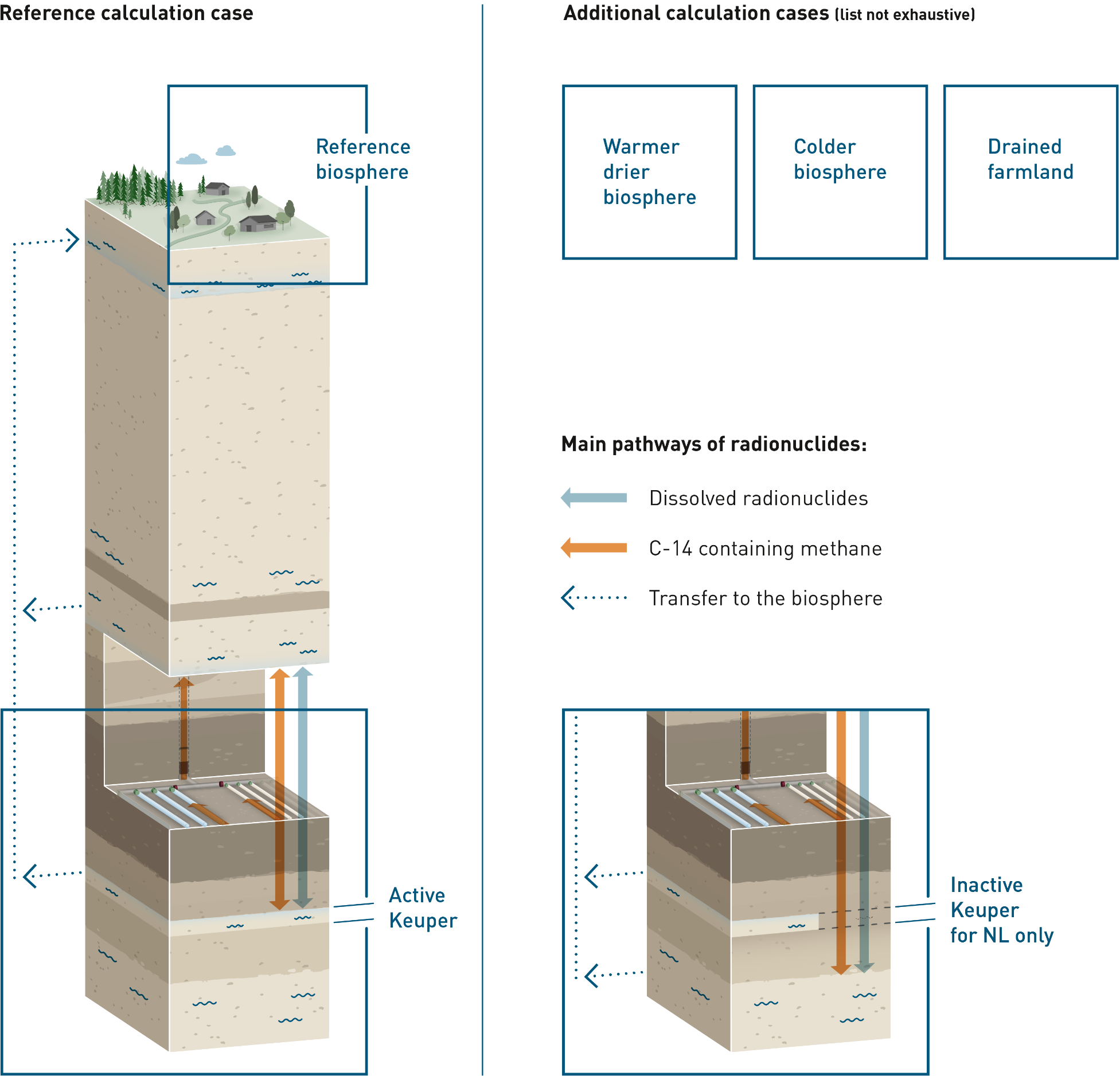The calculation cases for the reference and variant conceptualisations of the reference safety scenario are shown schematically in Fig. 7‑3. The calculation cases are propagated to radiological consequence analysis and are furthermore summarised in tables in Chapter 8, where the calculation results are presented and discussed.

Fig. 7‑3:Main pathways for radionuclide transport in the reference safety scenarios, showing, in the bottom left box, the reference conceptualisation with the hydraulically active Keuper aquifer and, the bottom right box, the variant with the inactive Keuper aquifer below the HLW repository section
The figure also illustrates the different biospheres which are handled as different calculation cases within the reference safety scenario.
Arrows in this and subsequent similar figures indicate, respectively:
Blue, bold: radionuclide migration in the aqueous phase, in which radionuclides are released to porewater that contacts the waste packages and are subsequently transported by aqueous diffusion and, where there is porewater flow, by advection,
Red, bold: radionuclide migration of 14C in the aqueous and gas phases (two-phase flow), in which gaseous radionuclides mix with, and are transported by, repository-generated gas,
Dotted blue arrows: Instantaneous transfer of radionuclides into the regional aquifer within the biosphere, conservatively neglecting the significant transport time with associated radioactive decay.
The modelling approaches used to simulate these migration pathways are summarised in Section 8.1 and described in Appendix B of NTB 24‑18 (Nagra 2024p), and in Chapter 4 of NAB 24‑07 Rev. 1 (Nagra 2024w).
The reference case (RS-RC)15 is a single, deterministic calculation case, with the conservative assumption that the Keuper aquifer is hydraulically active. A reference biosphere based on present-day climatic conditions is assumed. Where there is quantified uncertainty in the properties of repository features, rates of processes and other model parameters, realistic values are assumed (other uncertainties are generally handled using conservative assumptions). Three additional deterministic calculation cases are defined that assume different, though still steady-state, climatic and geomorphological conditions:
-
a warmer and drier climate (RS-BIOS/WARM_DRY),
-
a colder climate (RS-BIOS/COLD), and
-
a drained wetland surface environment (RS-BIOS/DRAINED_FARMLAND).
Further details of the reference and alternative biospheres, and of biosphere modelling in general, are provided in NAB 24-06 (Nagra 2024n).
Additional calculation cases are also defined that aim to identify, illustrate and quantify the impact of uncertainty in the parameters that control radionuclide retention and transport in the repository barriers:
-
a probabilistic calculation case (RS-PROB) with multiple realisations in which all uncertain parameters are randomly sampled from probability distributions, derived from an assessment of parameter uncertainty, to illustrate the range of uncertainty in calculated consequences and to provide the data for a global probabilistic sensitivity analysis to identify those parameters to which the calculated consequences are most sensitive,
-
a deterministic calculation case (RS-CMB) in which all parameters to which the radiological consequences are most sensitive, as identified in RS-PROB, are set to their most unfavourable value within their probability distributions.
Finally, a single deterministic calculation case (RS-KEUPER_INACTIVE) is defined for the variant in which the Keuper aquifer is hydraulically inactive below the HLW repository section.

